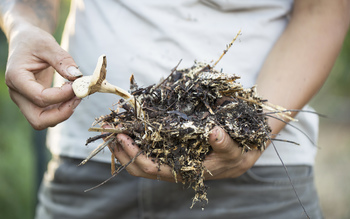How to make your own compost

Generally speaking, to make compost you will want to try and maintain a certain carbon to nitrogen ratio within the bin. This ratio is 30 parts carbon to 1 part nitrogen (30:1). This is not so much for the weed itself, but more so for the organisms that decompose your organic matter. This is the ratio bacteria operate most efficiently at, but it is not an indication of the actual nutritional value of the end product – this will come from the other qualities of the materials you decide to compost.
THE BROWN AND GREEN
Often, the carbon is referred to as the brown part, and the nitrogen as the green part. Thinking of the browns and greens makes it easier to identify sources of each more quickly. Matter containing much carbon tends to be brown in color, and similarly, matter with nitrogen is green.
Examples of biodegradable carbon
The cellulose within carbon provides food for the micro-organisms that break it down, making it vital to the process. Such matter includes:
- Dead leaves
- Straw
- Paper
- Woody plant trimmings (shrubs and tree cuttings)
- Pine needles
- Sawdust
Note: Sawdust can compact very easily and create impenetrable layers. This can inhibit both the micro-organisms and air circulation, causing anaerobic decomposition - something you want to avoid (see below).
Examples of biodegradable nitrogen
Nitrogen is used by the micro-organisms to build their cell structure and is not needed in vast quantities for them to function. Nitrogen is found abundantly in this matter:
- Manure
- Fruit
- Vegetables
- Plant waste
- Seaweed
- Coffee grounds
Note: when using manure it is handy to know that poultry manure, such as that which comes from chickens, is extremely high in nitrogen; whereas manure from other animals, such as horses, in generally high in both carbon and nitrogen.
WHAT NOT TO USE
Hot compost is amazingly efficient at killing pests and insects, but some waste can throw off the balance of the pile and disrupt the process. Don’t add dairy products, cooked foods, meats, diseased or infested plants, a herbicide sprayed plants, oils, and of course no plastic products.
AEROBIC VS ANAEROBIC DECOMPOSITION: THE IMPORTANCE OF AIR CIRCULATION
Aerobic simply means that air is involved, versus anaerobic, which means that no air is involved. Nutrient-rich compost is made through a process of aerobic decomposition. This process happens when air is able to circulate through the compost, ensuring the micro-organisms that perform the process have enough oxygen to survive.
Anaerobic decomposition occurs when air cannot circulate within the compost, causing the micro-organisms to die. You can tell when this is taking place as the compost will smell sour and unpleasant. When this happens the compost becomes toxic to plant life, so be careful not to use it with your hemp! To prevent anaerobic composting, a compost pile should be turned regularly to help circulate air. Most bought compost bins are designed to allow for a degree of air circulation.
SIGNS THAT YOUR COMPOST IS READY
If you are using a compost bin you will find that things at the bottom of the bin tend to be ready before those at the top, due to the continuous nature of constantly adding things in. Although some people will say that compost “is never ready” and can always compost more, you will know your compost is ready for plant to use when:
It is dark brown or black
It is soft to the touch
It is airy and crumbles easily in the hand
It has a pleasant (to some) earthy smell
When it comes to creating your own compost, the most important thing is to experiment and persevere – don’t give up! It takes time to master. Also, there is much more to be said about composting that can be covered here. Many excellent resources are available for more research on the topic. But most importantly - get started and get your hands dirty.
